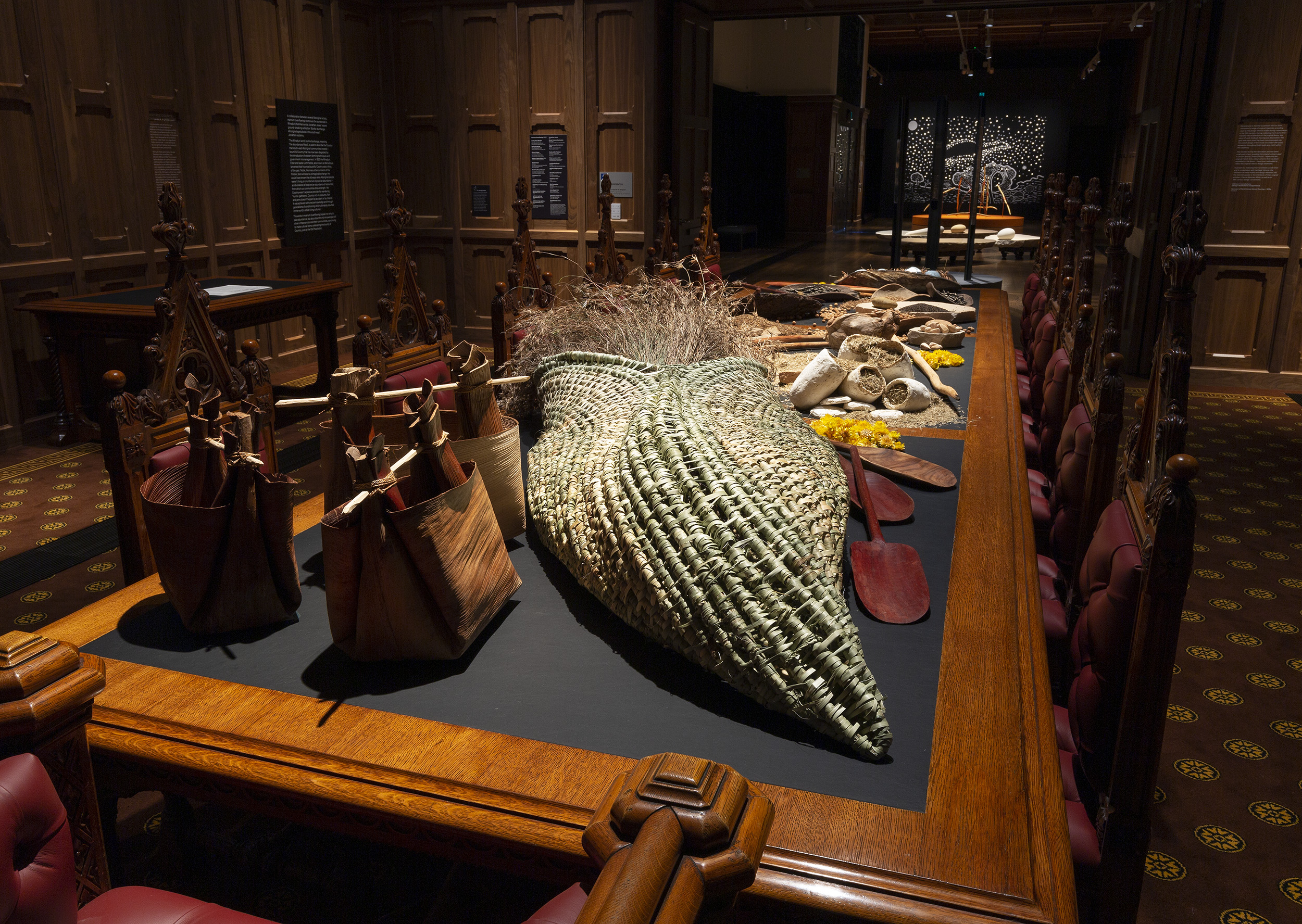


Aunty Kim Wandin
Dhangidj Binak (food basket) 2021
Spiny-headed mat rush, sedge, flax
Wurundjeri-Woiwurrung, born Healesville, Victoria 1958; lives and works Healesville, Victoria
Aunty Kim Wandin speaks on the Dhangidj Binak (food basket) she wove which features in Jonathan Jones’ marrum (overflowing) 2021.
Aunty Kim is a respected Wurundjeri-Woiwurrung elder and artist. This recording was made over cups of tea and lemon myrtle pound cakes at Aunty Joy Wandin’s dining table during NAIDOC week. The weather was cold, and so the ducted heating can be heard in the background.
Aunty Kim
My name’s Kim Wandin, traditional name Wandoon meaning spirit of the water, which comes from my great grandfather Robert Wandoon. I’m a Wurundjeri-Woiwurrung woman and I am very pleased to be part of the Emu Sky Exhibition. I’m a weaver, I make baskets and eel traps and I explore other sculptural ways of working and I’m interested in public space.
I learnt to weave a long time ago - I can't really even put a time on it because I think it's always been with me anyway it's part of my knowing as an Aboriginal person.
But my grandmother, Nanna Ollie, she showed me how to weave and it was taught to her by Granny Jemina out at coranderrk and it's a style that's quite unique in lots of ways.
I always use, like to use, Lomandra longifolia, the spiny headed matt rush, and in my bundles I use sedge or flax but the outside’s always lomandra.
When I weave it's actually a meditative process for me. I tend to take myself into this really beautiful space where I am imagining all of the women, you know, sitting on the river bank weaving, telling stories, talking about family and talking about a way of life. So I actually transport myself to that place and it is a really healing thing for me to be able to weave and also to be able to share my work with other people.
When I'm weaving I’m in the here-and-now physically, but yeah, spiritually I do go to a different place and it’s really a healing - and it's quite empowering to know that I’m creating something that comes from something ancient. The knowing of it is coming through my hands as I weave and it is very trance like a lot of the time and a very precious sacred space when I’m weaving, because I know ancestors are with me.
And by calling things in language like Dhangidj Binak, which is food basket in Woi Wurrung that's actually talking to the plants and when I go harvest for my weaving, I often talk to them and I often say “Djirra Djirra” and knowing that they’re the plants that I want to pick. I look at what's around. I know which plants are for me.
The processing of the lomandra is you harvest it, and then you take it and you put it in the sun. Sometimes I lay it on the ground but then later in the day I'll hang it up so the wind can get into it. So that can take, you know, anywhere between two and four weeks for the plant to dry out and then once it's dried, and I want to use it, I’ll soak it in water.
And some of these reeds here I’ve actually soaked in Coranderrk Creek water, so it has the essence of country - not just the plant, but it has, yeah, Coranderrk water involved in it.
And so I soak the reeds probably - look it can be three days, sometimes depending how old the plant is it can be up to a week. And I’ll know when it's ready when I wrap it around my finger and it doesn’t split. So then I know if it’s ready - it’s moist and supple enough for me to work with.
I only take what I need because I know the plants are always going to be there and by harvesting the plant you're giving them a new life because new shoots come up after you've collected what is needed for me to use.
With this particular project which has sort of taken me on about 60 hours of work, and I tend to work in the afternoon when I feel a little bit more settled in my day - and often my granddaughter is with me and she is always saying “Can I help? Can I weave with you too grandma?”.
So yeah I'm slowly showing her, and that really is, I think, what I need to do - is hand that on to family and then she can hand that on to her family, her grandchildren too. [END]
Close